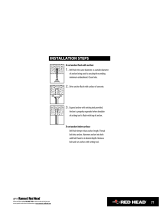
18
䡬 Please replace the drill bit after removing dust
collector (B).
6. Selecting the driver bit
Screw heads or bits will be damaged should an
inappropriate bit for the screw diameter be employed
to drive in the screws.
7. Selecting the function mode
You can switch functions to the 3 modes of “strike
only, “rotation + strike”, and “rotation only” by
turning the change lever while pressing the push
button. Set the ▲ mark position of the change lever
to that of the mode to be used.
CAUTION:
䡬 Before operating the change lever, check and make
sure that the motor has stopped.
A failure can occur if it is operated while the motor
is running.
䡬 If the change lever does not move up to the mark
position of each mode, carry out switching while
turning the grip end to left and right. Also, it can
become difficult to change the mode at low
temperature, and therefore perform warming-up.
䡬 To operate the change lever, press the push button,
and release the lock of the change lever. Also,
check and make sure after operation that the push
button has returned and that the change lever has
been locked.
䡬 Switch the change lever without mistake. If it is
used at a position halfway, there is a fear that the
service life of the switching mechanism may be
shortened.
䡬 Note that it is impossible to switch from “rotation
only” to “strike only” or from “strike only” to
“rotation only”. Switch over via “rotation + strike”.
(DH30PC)
HOW TO USE
CAUTION:
To prevent accidents, make sure to turn the switch off
and disconnect the plug from the receptacle when the
drill pits and other various parts are installed or removed.
The power switch should also be turned off during a
work break and after work.
1. Switch operation
The rotation speed of the drill bit can be controlled
steplessly by varying the amount that the trigger
switch is pulled. Speed is low when the trigger
switch is pulled slightly and increases as the switch
is pulled more.
2. Rotation + striking
This hammer drill can be set to rotation and striking
mode by pressing the push button and turning the
change lever to the
mark. (Fig. 4)
(1) Mount the drill bit.
(2) Pull the trigger switch after applying the drill bit
tip to the drilling position. (Fig. 5)
(3) Pushing the hammer drill forcibly is not necessary
at all. Pushing slightly so that drill dust comes out
gradually is sufficient.
CAUTION:
When the drill bit touches construction iron bar, the
bit will stop immediately and the hammer drill will
react to revolve. Therefore grip the side handle and
handle tightly as shown in Fig. 5.
3. Rotation only
This hammer drill can be set to rotation only mode
by pussing the push button and turning the change
lever to the
mark. (Fig. 6)
To drill wood or metal material using the drill chuck
and chuck adapter (optional accessories), proceed
as follows.
Installing drill chuck and chuck adapter: (Fig. 7)
(1) Mount the drill chuck to the chuck adapter.
(2) The part of the SDS-plus shank is the same as the
drill bit. Therefore, refer to the item of “Mounting
the drill bit” for attaching it.
CAUTIONS:
䡬 Application of force more than necessary will not
only expedite the work, but will deteriorate the tip
edge of the drill bit and reduce the service life of
the hammer drill in addition.
䡬 Drill bits may snap off while disengaging the hammer
drill from the jammed hole. For disengaging, it is
important to use a pushing motion or turn the drill
bit counterclockwise.
䡬 Do not attempt to drill anchor holes or holes in
concrete with the machine set in the rotation only
function.
䡬 Do not attempt to use the hammer drill in the
rotation and striking function with the drill chuck
and chuck adapter attached. This would seriously
shorten the service life of every component of the
machine.
4. When driving machine screws (Fig. 8)
First, insert the bit into the socket in the end of
chuck adapter (D).
Next, mount chuck adapter (D) on the main unit
using procedures described in 4 (1), (2), (3), put the
tip of the bit in the slots in the head of the screw,
grasp the main unit and tighten the screw.
CAUTIONS:
䡬 Exercise care not to excessively prolong driving
time, otherwise, the screws may be damaged by
excessive force.
䡬 Apply the hammer drill perpendicularly to the screw
head when driving the screw; otherwise, the screw
head or bit will be damaged, or driving force will
not be fully transferred to the screw.
䡬 Do not attempt to use the hammer drill in the
rotation and striking function with the chuck adapter
and bit attached.
5. When driving wood screws (Fig. 8)
(1) Selecting a suitable driver bit
Employ cross-recessed screws, if possible, since the
driver bit easily slips off the heads of slotted-head
screws.
(2) Driving in wood screws
䡬 Prior to driving in wood screws, make pilot holes
suitable for them in the wooden board. Apply the
bit to the screw head grooves and gently drive the
screws into the holes.
䡬 After rotating the hammer drill at low speed for a
while until the wood screw is partly driven into the
wood, squeeze the trigger more strongly to obtain
the optimum driving force.
CAUTION:
Exercise care in preparing a pilot hole suitable for
the wood screw taking the hardness of the wood
into consideration. Should the hole be excessively






















